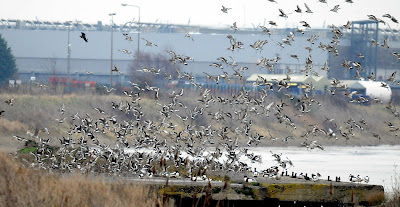Woodcock hunting At the moment the year list for the Valley is on 69, barring a possible Yellow Legged Gull it may well soon hit 70, one bird that I thought may well push it up was Woodcock.
With a good number having been seen recently, Les had 4 in one day, I dropped into the Valley mid-morning on Saturday.
Like any site there are particular species ‘ hotspots ‘ the latest one seems to be Berwick Glades for Woodcock, I left that till last and firstly did the Reservoir. The same Gull, be it Herring or Yellow Legged was again on the Reservoir, it has been present over a few weeks now, have a look at photos below, to me it looks good for Yellow Legged if both are the same bird. 7 Wigeon were also on the Reservoir and I had a brief view of the Ross’s Goose as it left for the top paddock with a good number of Greylags.
 |
| Seen on Jan 15th |
 |
| Dark mantle |
 |
| In flight showing Yellow Legs |
 |
| Seen on Feb 2nd - possibly the same bird |
 |
| In flight legs look Yellow |
After the Res I started searching every copse, along the way I came across 30 Siskin preening and sub singing in a Hawthorn, the adjoining Alders had probably pulled them in, the light at the time was awful.
I also came across a couple of trees in a small section of woodland that had been freshly gnawed with the bark eaten, I have never seen or come across sign of a Muntjac in the Valley, but other than Roe Deer it is the only animal I think it can be. Roe Deer I would not expect around our way either.
 |
| Muntjac or Roe Deer? |
I eventually came to the Glades, picking up a good size flock of Lesser Redpoll along the way, easily 40 birds and loosely associating with them was around 20 Yellowhammers, as mentioned above not good for photos so images are poor.
 |
| Male Siskin poor photo |
 |
| Mostly Lesser Redpolls |
 |
| Ross's |
I would like to say that after walking most of the Glades for an hour, I was dripping in Woodcock, but unfortunately not one, it looked absolutely ideal for them I must say, so I think the exercise will likely be repeated this weekend.
A good walk, notable absentees from the list so far are Sparrowhawk, Little Egret and Bullfinch, you are now more than likely to see Common Buzzard rather than Sparrowhawk over the Valley, good to see the fortunes changing of this larger Raptor, it went on the list on the first visit of the year.


























































